
Table of Contents
All about ITR-4 for Income Tax Return Filing
The ITR-4 form, also known as ‘Sugam’, is a crucial document used by individual taxpayers in India, specifically designed for those who operate as professionals or engage in businesses that fall under the presumptive taxation scheme as per Sections 44AD, 44ADA, or 44AE of the Income Tax Act. This form requires taxpayers to furnish comprehensive details about their income, expenses, and deductions, making it essential for calculating their taxable income and subsequently their tax liability. Individuals eligible to file ITR 4 for Income Tax Return Filing typically include freelancers, small business owners, and professionals like doctors, lawyers, and consultants, provided their total gross receipts do not exceed Rs. 2 crores in a financial year.
The form necessitates disclosing information on various heads, such as income from business or profession, salary, house property, capital gains, and other sources. Additionally, taxpayers must provide details of their deductions under various sections of the Income Tax Act to claim exemptions and reduce their taxable income. Accuracy in filling the ITR-4 form is vital, as any discrepancies or omissions can lead to potential penalties or legal consequences. Therefore, taxpayers should maintain thorough records of their financial transactions, consult CA for filing Income Tax Return if necessary, and ensure timely submission of the ITR-4 to fulfill their tax obligations in India.
Who is eligible for ITR-4 Filing?
In India, the ITR-4 form is primarily meant for ITR Filing for Salaried Employees, individuals, and Hindu Undivided Families (HUFs) who operate as professionals or engage in businesses and fall under the presumptive taxation scheme as per Sections 44AD, 44ADA, or 44AE of the Income Tax Act. A Resident Individual/ HUF/ Firm (other than LLP) can file ITR 4 if they have:
- Income not exceeding Rs. 50 Lakhs during the FY.
- Income from Business and Profession (e.g. Doctor, Lawyer, CA, etc.) that has been computed on a presumptive basis under sections 44AD, 44ADA, or 44AE of the Income Tax Act.
- Income from salary/ pension, one house property
- Agricultural income (up to s. 5000/-)
- Income from other sources including family pension, interest on the savings account, deposits (bank/ post office/ cooperative society), enhanced compensation, and other interest.
Who is not eligible for ITR 4 Filing?
An Individual/ HUF/ Firm (other than LLP) is not able to file ITR 4 if they have:
- are RNOR i.e. Resident Non Ordinarily Resident and NRI i.e. Non Resident Indian.
- total income exceeding Rs. 50 Lakhs.
- agriculture income of more than Rs. 5000/-
- are Director in a company
- income from more than one house property
- income winning from the lottery
- income from horse races
- held any unlisted equity shares at any time during the previous year
- deferred income tax on ESOP that has been received from the employer being an eligible start-up
- are not covered under the eligibility conditions of ITR 4.
ITR 4 Filing Last Date
The Income Tax Return last date for filing ITR4 is typically the same as for other forms, providing protection from penalties for late filing.
What is the structure of ITR-4?
Part A – General Information:
- This section includes basic details of the taxpayer including taxpayer’s name, PAN (Permanent Account Number), address, date of birth, and contact information.
Part B – Gross Total Income:
- This section consists of multiple sub-sections where you have to report various types of income, including:
- Income from Salary/Pension
- Income from House Property
- Income from Other Sources
- Gross Total Income
Part C – Deductions and Taxable Total Income:
- In this section, you can claim the deductions under various sections of the Income Tax Act so that your taxable income can be reduced.
- Deductions under Section 80C to 80U
- Total Income (after deductions)
Part D – Computation of Tax Payable:
- This section calculates the income tax liability based on the taxable income and applicable tax rates.
Part E – Other Information:
- This section includes details related to your tax payments, advance tax, self-assessment tax, and the tax deducted at source (TDS) during the financial year.
Part F: Schedule BP: Computation of Income for Business or Profession:
- Schedule BP is a critical part of ITR-4, where taxpayers engaged in business or profession under the presumptive taxation scheme (Section 44AD) provide details of their business income, expenses, and deductions.
Part G: Schedule OS: Income from Other Sources:
- In this section, you have to report the income from other sources apart from business or profession, such as interest income.
Part HA: Details of Assets and Liabilities at the End of the Year (only for individuals and HUFs having income from business or profession):
- You have to provide the information about all your assets & liabilities if you fall under the category of individuals or HUFs with business or professional income.
Part I: Computation of Income
- This section contains details of your income from business or profession under the presumptive taxation scheme, including turnover and income calculation.
Part II: Tax Computation and Return:
- This part summarizes the tax calculation based on details provided earlier and mentions any refund or tax payable.
Verification:
- The taxpayer has to verify the ITR-4 form, declaring the accuracy of the information that has been provided by them.
Schedules:
- There are various schedules attached to the ITR-4 form, which may apply according to the circumstances of the taxpayers. These schedules can include details like depreciation, details of partners in the firm, and more.
It’s essential to carefully fill out each section of the ITR-4 form, providing accurate and complete information to ensure compliance with the Income Tax Act. Additionally, the specific structure and requirements of the ITR-4 form can change from year to year, so it’s crucial to refer to the latest version of the form and any accompanying instructions provided by the Income Tax Department and consult the Income Tax Return Filing agents near me.
How to file ITR 4
In India, the process of filing ITR 4 involves a series of steps which have been mentioned below-
Step 1: Official website for e-filing
Firstly, you have to visit the official website for e-filing of income tax return which is https://www.incometax.gov.in/iec/foportal/
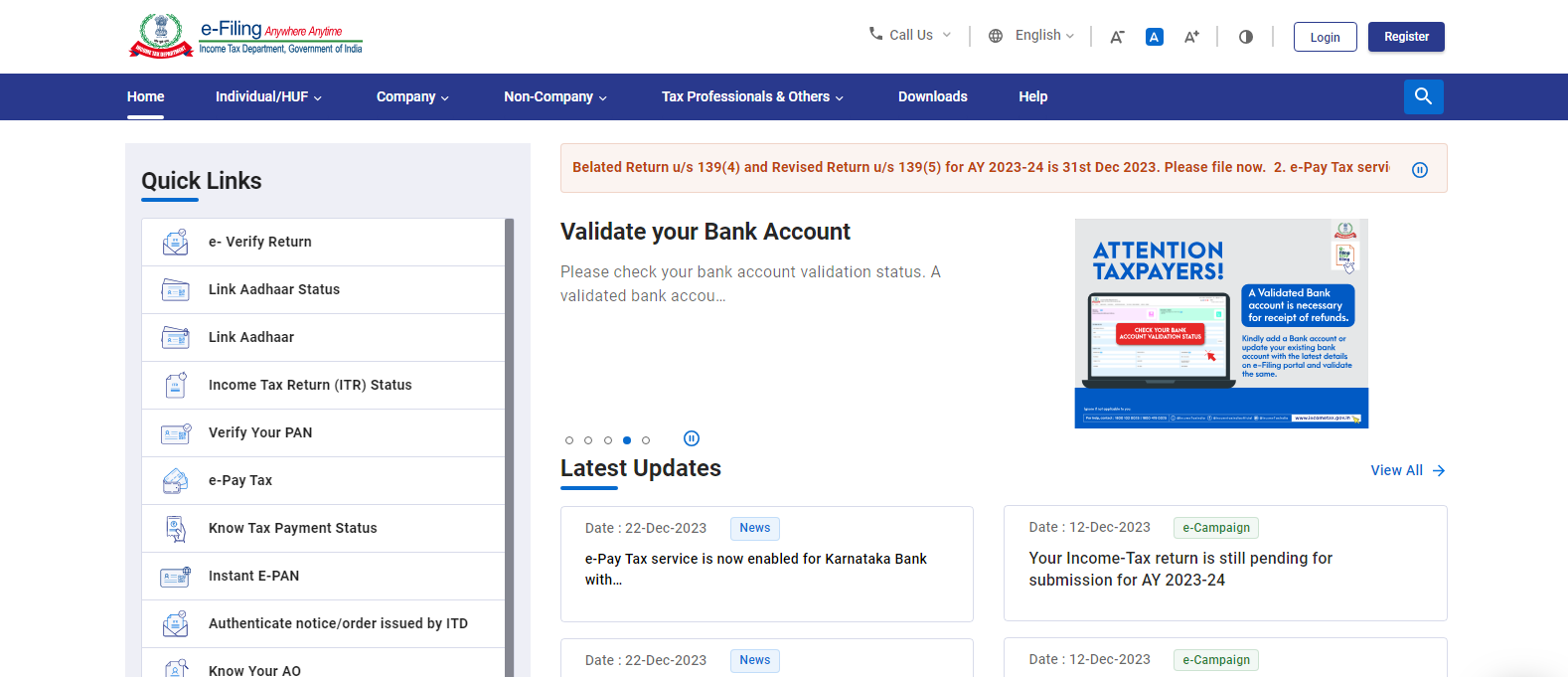
Step 2: Register/ Login
If you are a first-time user you have to register yourself

If you are a repeat user you have to log in to the website-
- You have to enter your PAN as your user id and then click ‘Continue’.
- You have to check the security message given in the tick box.
- Then, you have to enter your password & click on the ‘Continue’ button.

Step 3: Selecting the option of ‘File Income Tax Returns’
After logging in, you will see the e-file menu on the menu bar. When you click on the e-file menu then, you will get the option of ‘Income Tax Returns’ on clicking you will see the option of ‘File Income Tax Return’ and you have to click on that option.

Step 4: Select the assessment year
After that, you will be redirected to the page of Income Tax return where you have to select the ‘assessment year’ and the ‘mode of filing’ for which you wish to file the income tax return and then you have to click on ‘Continue’
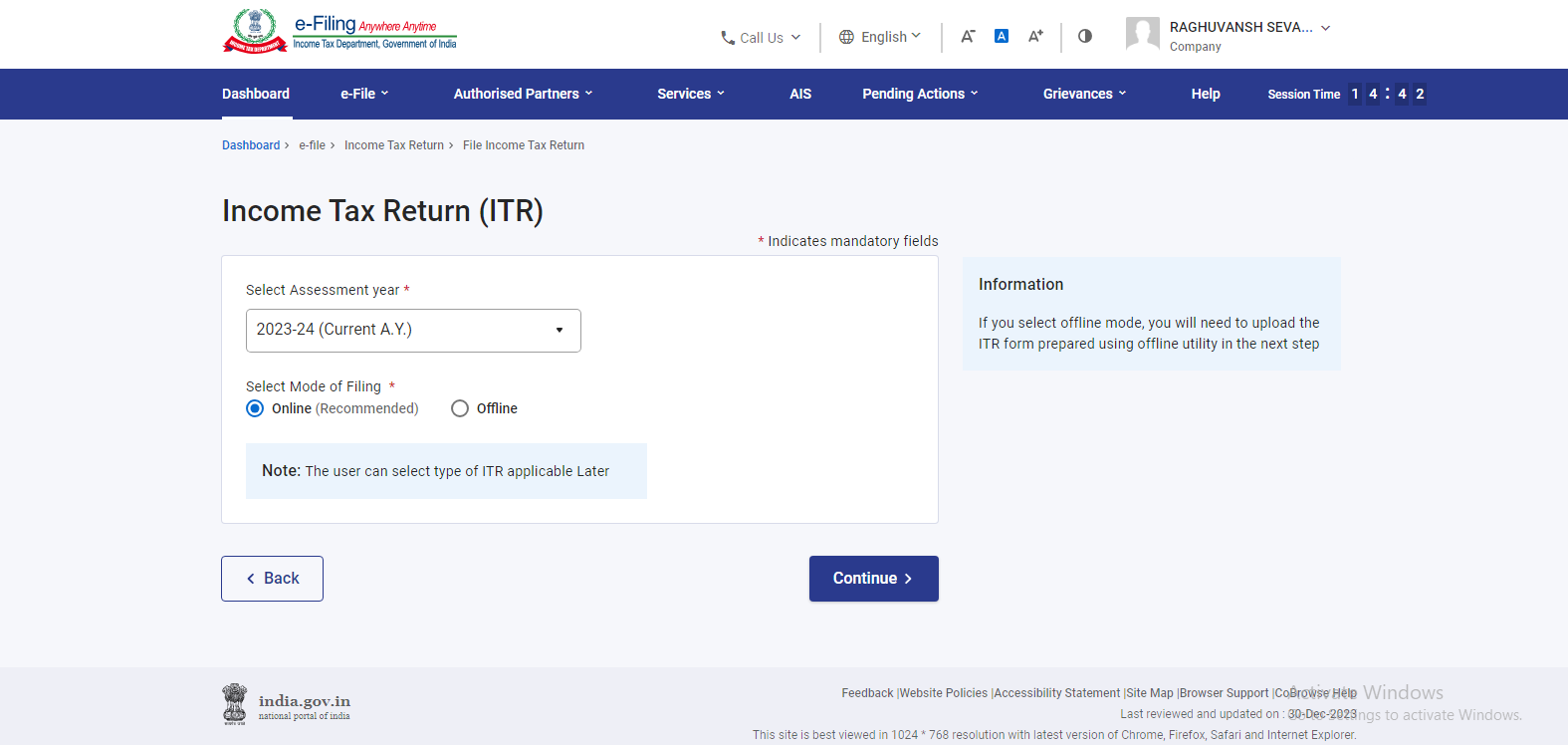
Step 5: Select the status
Then, you have to select the status of filing ITR as Individual and click on ‘Continue’
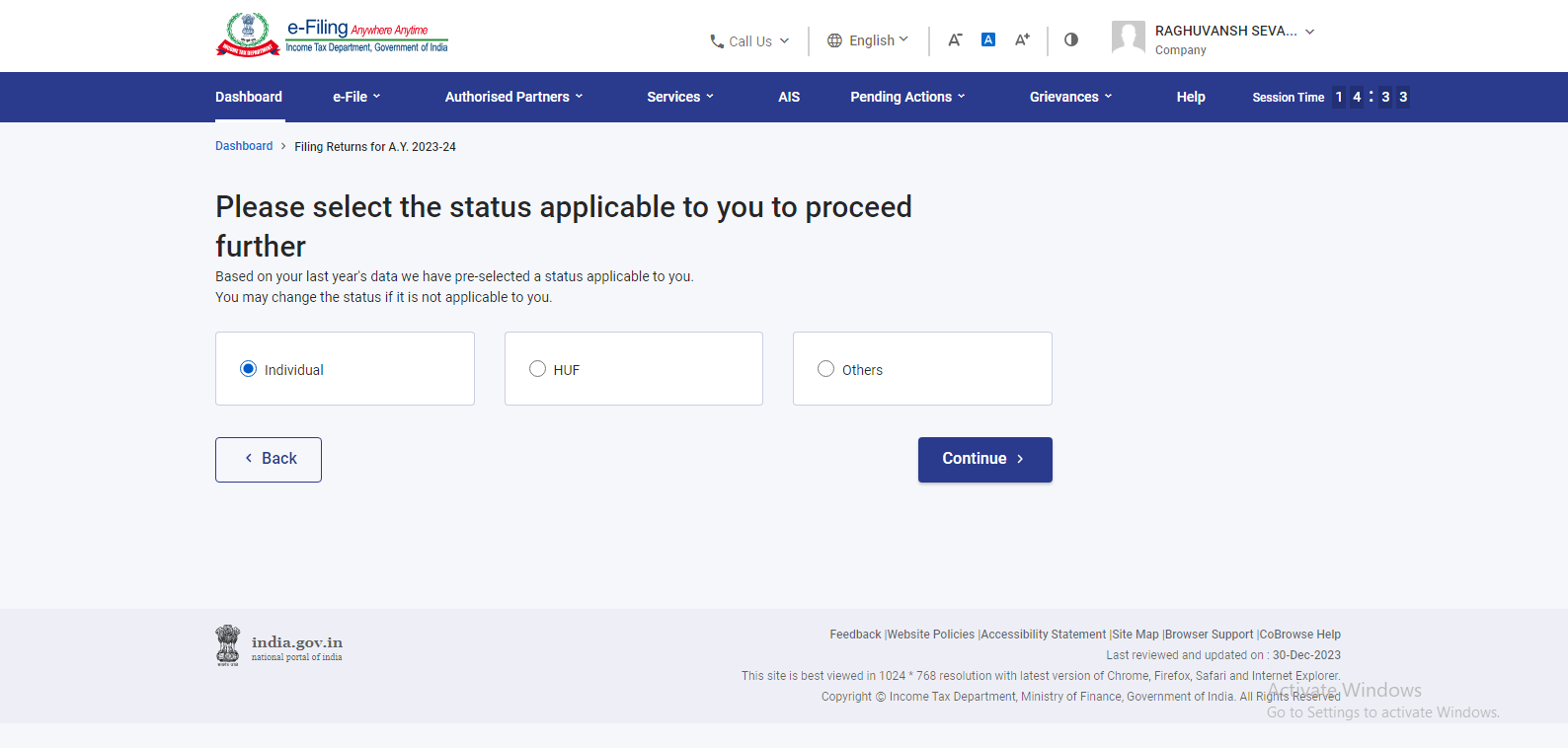
Step 6: Select the ITR type
After that, you have to select the type of ITR form where you have to choose the ITR 4.
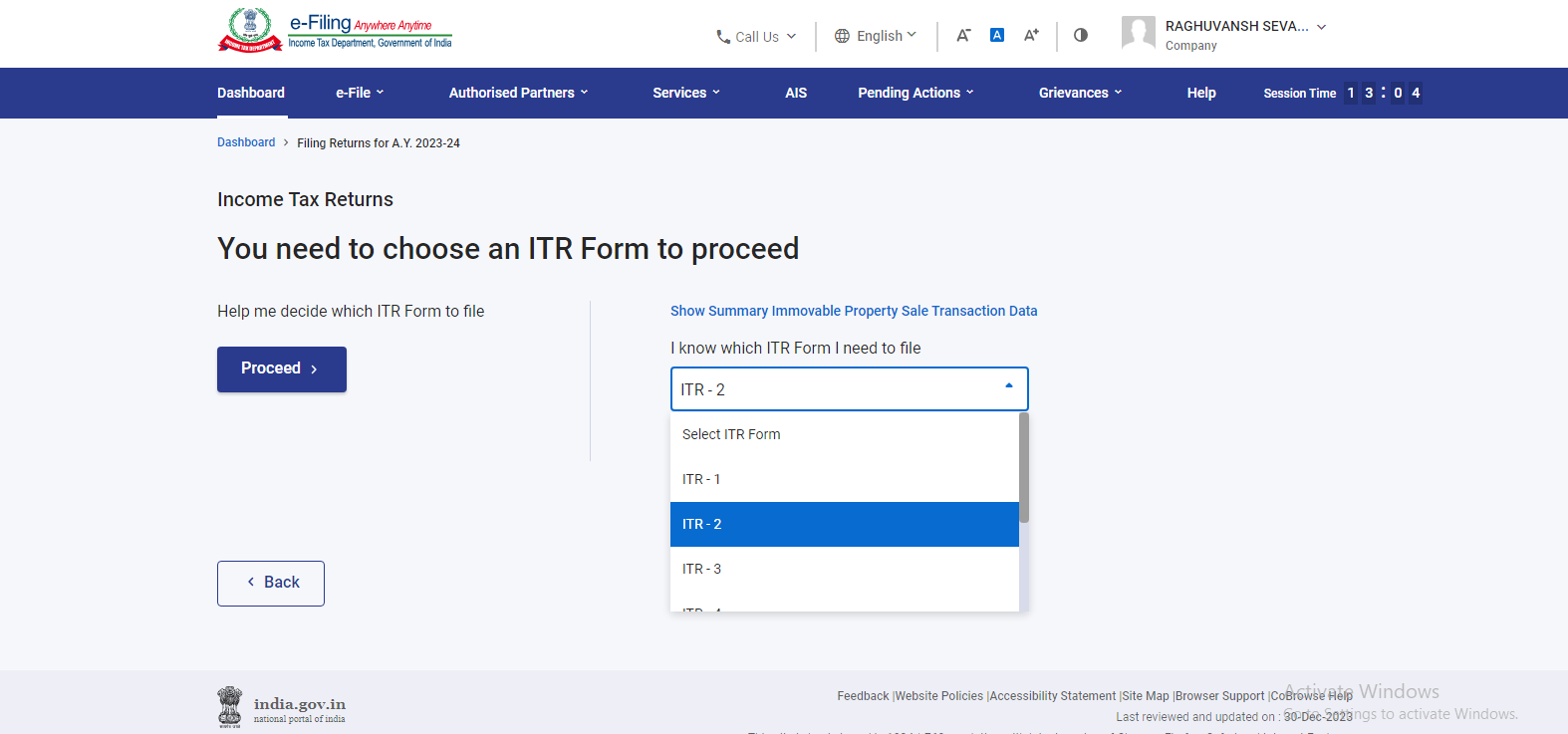
Step 7: Filling online form
Then, you have to fill the online form including the schedules.
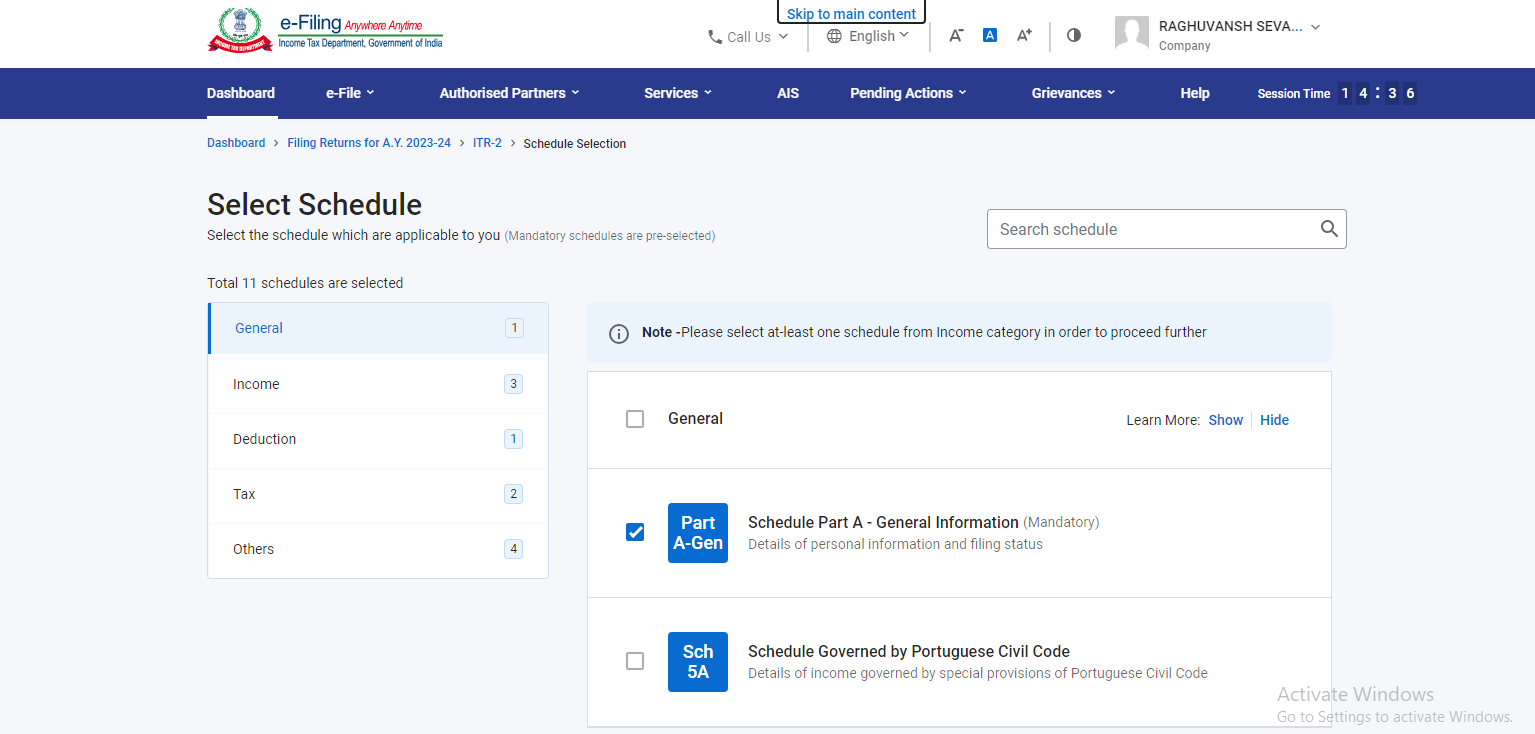
Step 8: Submit bank account details & other information
After have to add your bank details and other information. If already been submitted, then you have to make sure that it has been pre-validated. You have to review the correctness of pre-filled information that has appeared on the new page.

Step 9: Upload Digital Signature (if available):
If you have a digital signature, you can upload it for electronic verification.
Step 10: e-verification of ITR
E- Verification of ITR is the most crucial step. Your Income Tax Return will be incomplete until you verify it. You have the option to e-verify the ITR via Aadhaar OTP, Net banking EVC i.e. Electronic Verification Code, or by sending a physical copy of the ITR to CPC Bengaluru.
Step 11: Submission of ITR
At last, you have to click on the ‘Submit’ button to submit your ITR. After submission, you will get the acknowledgment from the Income Tax department.
Documents Required for ITR-4 Filing
-
PAN Card
Your Permanent Account Number (PAN) card is essential for filing your income tax return.
-
Aadhaar Card
Linking your Aadhaar card to your PAN card is mandatory for filing income tax returns. Make sure your Aadhaar details are up-to-date.
-
Bank Statements
Gather bank statements for all your bank accounts for the financial year. These statements will help you verify your income and deductions.
-
Form 26AS
This is your annual tax statement that provides details of TDS (tax deducted at source) deducted from your income. You can access Form 26AS online through the Income Tax Department’s website.
-
Income Details
- Salary Income: Form 16 issued by your employer, which includes details of your salary, TDS, and deductions.
- Business or Professional Income: Books of accounts, profit and loss statements, balance sheet, and other relevant financial documents
- Rental Income: Rental agreements, lease deeds, and details of rental income received
- Other Sources of Income: Documentation for income from interest, dividends, capital gains, or any other sources
-
Deduction Details
- Proof of investments and expenses for deductions under various sections of the Income Tax Act (e.g., Section 80C, 80D, 80G, etc.).
- Receipts or certificates for deductions like home loan interest, education loan interest, or medical insurance premium
-
Advance Tax and Self-Assessment Tax Payments
Details of advance tax and self-assessment tax payments made during the financial year, including challans and receipts
-
Details of Taxable Assets and Liabilities (if applicable)
- Details of assets and liabilities, including immovable property, movable property, and loans, as required in Schedule AL.
-
Form 26QC (TDS on Rent)
If you are a landlord receiving rent exceeding a specified limit, you may need to provide Form 26QC details.
-
GST Information
If you are registered under the Goods and Services Tax (GST), you may need to provide GST-related information.
-
Documents for Verification
Any supporting documents that may be needed for verification or audit purposes, such as invoices, receipts, bills, or agreements.
-
Previous Year’s ITR
Copy of your previous year’s filed ITR, as it may contain information relevant to the current year.
-
Bank Account Details
Bank account details, including account number and IFSC code, for receiving income tax refunds, if applicable.
-
Other Relevant Documents
Any other documents or records related to your income, deductions, or financial transactions that may be required to substantiate your claims in the tax return
-
Receipts for donations made
-
Rent receipts
-
Rental agreement
-
Investment premium payment receipts
It includes LIC, ULIP, etc.
It’s essential to keep these documents organized and readily accessible when filing your ITR-4. Additionally, ensure that you report accurate and complete information to comply with tax laws and avoid any potential issues with the tax authorities. Consulting with the ITR Filing agents near me can be helpful if you have complex financial transactions or need guidance with your tax return.
Conclusion
The ITR-4 form, also known as “Sugam,” is a crucial document used for Income Tax Return Filing in India, primarily by individuals, Hindu Undivided Families (HUFs), and firms operating under the presumptive taxation scheme. It serves as a comprehensive tool for reporting income, deductions, and tax liability, especially for those engaged in businesses or professions with turnover or gross receipts within specified limits. Filing ITR-4 accurately and on time is essential to ensuring compliance with the Income Tax Act and fulfilling one’s tax obligations. Taxpayers should gather the necessary documents, maintain financial records, and seek professional assistance from CA near me for ITR Filing if needed to navigate the complexities of tax filing and stay in compliance with Indian tax laws.
At LegalPillers, we are here at your service for providing the Income Tax Return Filing near me. So, to avoid any complications about the tax law make LegalPillers your trusted partner for filing the ITR. We help you with our service with reasonable ITR Filing fees by CA.
Frequently Asked Questions (FAQs) related to ITR-4 Filing (Income Tax Return-4) in India
-
What is ITR-4?
- ITR-4 is an income tax return form in India designed for individuals, Hindu Undivided Families (HUFs), and firms who fall under the presumptive taxation scheme as per Sections 44AD, 44ADA, or 44AE of the Income Tax Act.
-
Who can file ITR-4?
- Individuals, HUFs, and firms that meet the criteria for presumptive taxation can file ITR-4.
-
What is presumptive taxation?
- Presumptive taxation allows taxpayers to declare income at a prescribed rate without the need for detailed accounting. It simplifies taxation for small businesses and professionals.
-
What are the eligibility criteria for filing ITR-4?
- Individuals and HUFs with business turnover or gross receipts up to Rs. 2 crores can use ITR-4.
-
What is the due date for filing ITR-4?
- The due date for filing ITR-4 varies from year to year but is typically on or before July 31st of the assessment year.
-
Can ITR-4 be filed electronically?
- Yes, ITR-4 can be filed electronically through the Income Tax Department’s e-filing portal.
-
What are the key sections of ITR-4?
- ITR-4 consists of sections for general information, income details, deductions, computation of tax payable, and other financial disclosures.
-
What documents are needed for filing ITR-4?
- Documents include PAN card, Aadhaar card, bank statements, Form 26AS, income and deduction proofs, and relevant financial records.
-
Is it mandatory to link Aadhaar with PAN for filing ITR-4?
- Yes, linking Aadhaar with PAN is mandatory for filing income tax returns.
-
What deductions can be claimed in ITR-4?
- Deductions under various sections of the Income Tax Act, such as Section 80C, 80D, and 80G, can be claimed.
-
How is tax calculated in ITR-4?
- Tax is calculated based on the taxable income, which is the gross income minus deductions and exemptions.
-
What is the penalty for late filing of ITR-4?
- Late filing can attract penalties and interest as per the Income Tax Act. The penalty amount depends on the delay period.
-
Can revised returns be filed using ITR-4?
- Yes, taxpayers can file revised returns using ITR-4 if they discover errors or omissions in their original filings.
-
What is Form 26AS, and why is it important for ITR-4?
- Form 26AS is an annual tax statement showing TDS and other tax-related information. It is crucial for cross-verification while filing ITR-4.
-
Is GST information required for ITR-4?
- If applicable, GST information may need to be provided, especially for businesses registered under GST.
-
What is the penalty for incorrect information in ITR-4?
- Providing incorrect information can lead to penalties, fines, or legal consequences, so accuracy is crucial.
-
Can I file ITR-4 if I have income from sources other than business or profession?
- No, if you have income from sources other than business or profession, you should use the appropriate ITR form for those income sources.
-
Is it advisable to seek professional help for filing ITR-4?
- Tax professionals or chartered accountants can provide guidance, especially if you have complex financial transactions or doubts about tax compliance.
-
Can I file ITR-4 offline?
- ITR-4 can only be filed electronically, and offline filing is not available.
-
Where can I get the latest version of the ITR-4 form and instructions for filing?
- The latest version of the ITR-4 form and instructions can be found on the official website of the Income Tax Department of India.


Leave a Reply